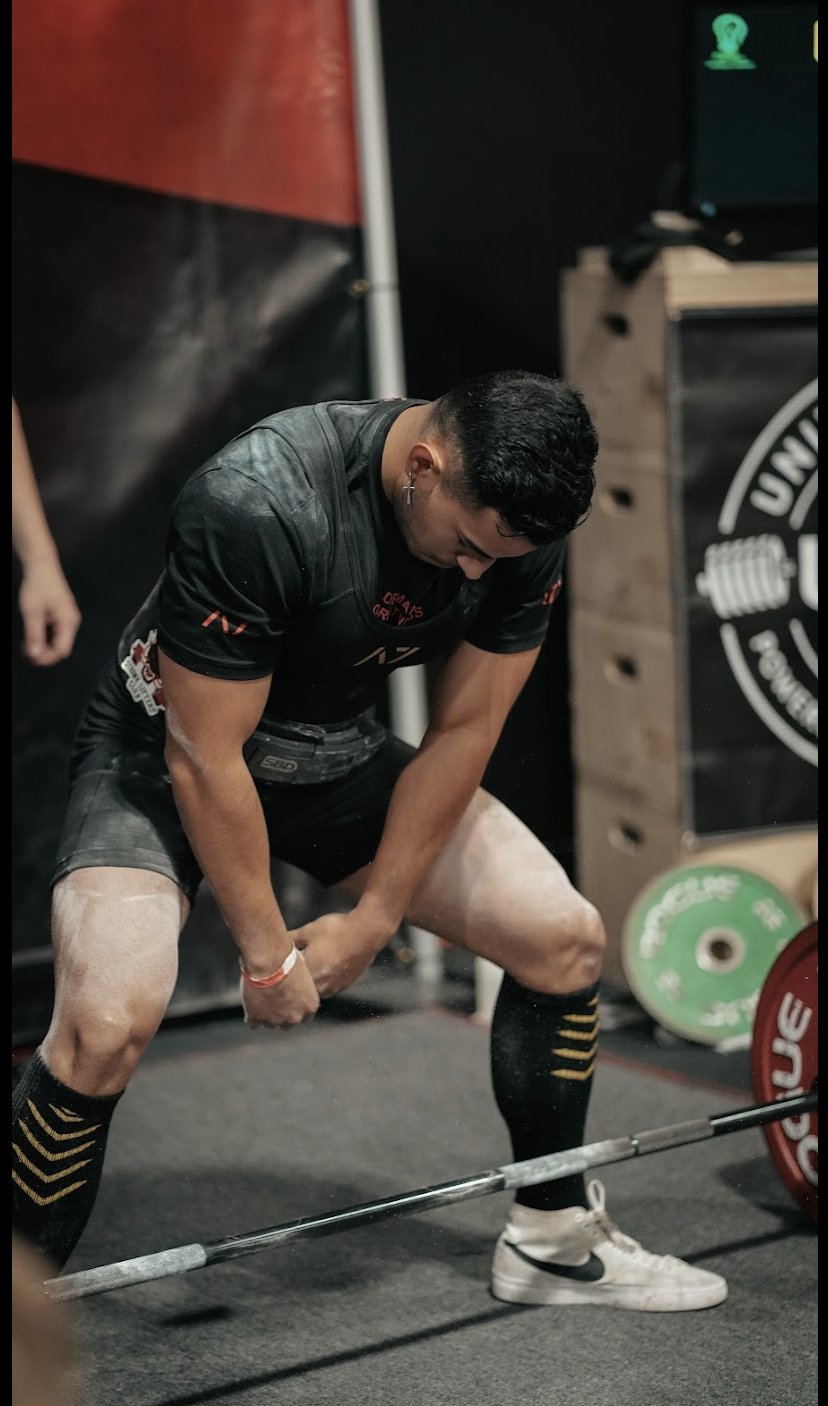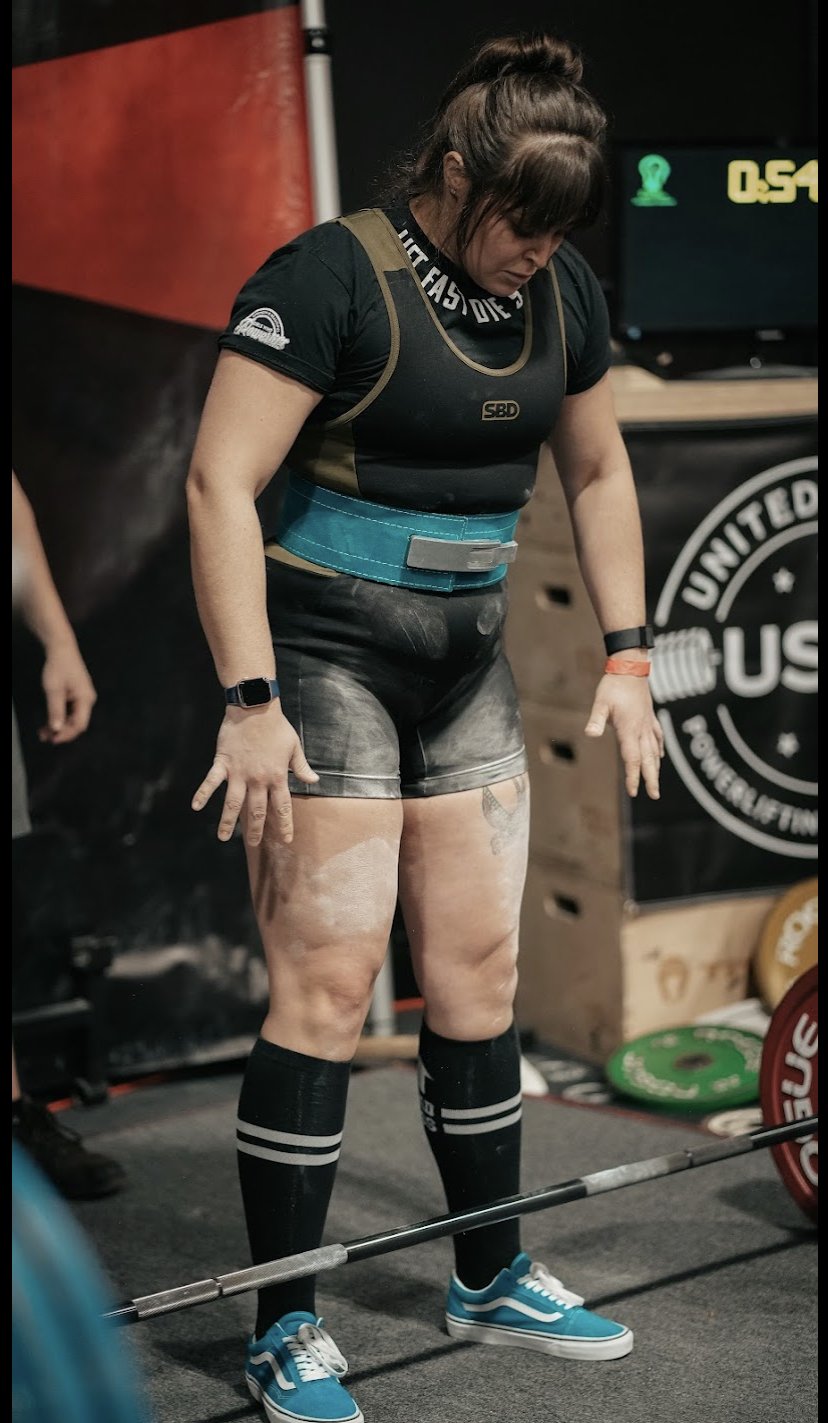The Case For Front Squats in Powerlifting Programming
Front squats. You love ‘em or you hate ‘em. They’re a notorious exercise for a reason. While many see Front Squats as either an old-school bodybuilding exercise or a staple in Oly lifting, they have a huge carryover to Powerlifting. Yep, you read that right! There’s a method behind the madness. Front squats have become an integral variation in both my athletes’ programs and my own because they pay off every time. Read below to find out why they’re so helpful & how you can include them to unlock those next-level gains.
Benefits
If Front squats are seemingly so foreign to Powerlifting, why would you perform them? Turns out, there’s a host of reasons.
A) Improved Back Squat Positioning, Strength out of the hole
Front Squats inherently make you squat better. Period.
Many athletes struggle with “good-morning” their squats, putting all their weight in their heels, losing bar path, and shooting up their hips out of the hole.
Or, they lose upper back tension and round over, falling forward, making it more difficult to stand back up.
What does the Front Squat improve? These two qualities.
Because of the upright position, there’s a greater demand on your quads and lats. If you try to “good-morning” a rep or get loose through your upper back- you will fall forward. You’re required to push through your toes, use your quads on the ascent, and maintain rigidity through the spine to stand up with the weight.
Using variations that naturally cue your technique can help drill those movement patterns into your body & brain, so when you go to Low Bar, you’ll know what to do.
And when you’re better at maintaining tension out of the hole, you’ll be stronger in that portion of the lift, too.
B) Improved positioning & strength off the floor for Deadlifting
Yep, front squats don’t only help your Low bar, they also help your deadlifts. Magic, right?!
The reasoning is similar: the demand on your upper Back & quads in a Front squat also help your deadlift. You must maintain lat tension to get the most out of your pull off the floor & keep the bar close to your body. Quads help you with that initial push to get the bar moving. And the extra core recruitment helps cue spinal position throughout the lift.
The motion of *pushing* through the floor in a Front squat is similar to that in a deadlift. That way, you’ll be able to break that heavier weight off the ground.
A strong upper back, quads, core, and better body awareness will help your deadlift out, all the more reason to incorporate some Front Squats in your programming.
C) New stimulus: movement variation
As Powerlifters, we perform the same movements over and over. While specificity is essential, especially closer to a meet, having variety is important too. Doing the same squat variation on repeat for months can eventually lead to staleness, hindering your progress. Simply building a different lift can be the stimulus you need to break that new PR. Front squats can be a phenomenal variation in an off-season to help you continue building strength differently- so your competition squat won't stagnate.
D) Upper Back Strength, Core Strength, Quad Strength, Mobility
As mentioned above, Front Squats help strengthen your upper back, core, and quads. These are areas that many lifters are lagging in, already making them a helpful tool.
When performing a proper Front Squat, keeping your elbows up requires lat & upper back strength to support that position.
The anterior load requires more from your abs, helping enforce your bracing pattern.
The increased forward knee travel (since you’re more upright) and forward center of gravity demands more from your quads, building leg strength.
Additionally, Front Squats can improve your mobility. For one, with a more acute knee angle, you need more ankle mobility. If you can front squat to depth, you can certainly back squat to depth. Lifters often squat a bit lower in a Front squat, also improving hip mobility & strength in that end-range position. The “elbows-up” requires thoracic mobility, an area that many people lack. And supporting that weight on your fingertips keeps your wrists more mobile, too.
You’re not just doing random stretches, you’re using these positions in a “functional” way, helping you become a stronger and more resilient athlete. Mobility gained from a front squat can directly improve your back squat strength- along with other movements.
E) Exciting goal to work toward
When you’re less focused on your big three lifts, it's harder to look forward to training sessions. Without specific goals to chase, training is less motivating. We know it’s important to have variety & not go for PRs 24/7, but still, it’s not as fun!
That’s where secondary lifts come in. While in an off-season block, you can shift your focus toward getting a stronger front squat, for example. Watching that number go up & knowing it will carry over to your other lifts can be just the fire you need to propel you forward. We like chasing progress- it’s what keeps us going, even if the method is changed. This alone is a significant benefit- the mental side of training is what keeps you physically in the game.
2. Programming Tips
Knowing that this lift is so beneficial, what is the best way to incorporate it into your training? Well, there are many ways to go about it:
A) For Volume
Volume Front Squats is a staple method. Get your work capacity up, build some beefy quads & upper back endurance, and murder yourself. A standard 5x5 is a great option, but with front squats, I’m a fan of even sets of 8, 10, and 12 if you want to go for hypertrophy. This rep scheme can be your primary lift of the day or used as a burnout after your main work.
B) For Strength
If you’re training Front squats regularly over time, you’ll want to include them in lower rep ranges & higher percentages as well. You can get a lot of benefits from incorporating heavy ones, too! In a Strength Block, build your front squat strength with 3-5 sets of 3-5 reps in the 75-90% range. Guarantee, this lift will blow up, which likely means a heavier low bar & big pull, too.
C) As a main squat day
During an off-season, Front Squats can replace your High Bar or Low Bar day. Doing so allows you to spend phases emphasizing this movement, becoming stronger and more proficient.
D) Secondary squat day
In damn near any training phase, Front Squats can be a secondary lift. This method is an effective way to:
a) build up any weaknesses you’re experiencing, and,
b) naturally undulate intensity- since your Front Squat *should* be lighter than your Back Squat, you can help manage fatigue by having a lighter (yet challenging) Front Squat day.
3. Variations
Just like a good ‘ole back squat, there are many ways to vary a Front Squat! Here are some different uses of the Front rack:
-Zombie Front Squats: A no-hands variation that is great for teaching the front rack position and further training core & upper back stability.
-Tempo Front Squats: If you want to put more stress on your quads, build strength out of the hole, use a bigger brace than ever before, and almost choke yourself (jk, but not really), add a tempo to your front squats. Slowing down the eccentric or pausing at the bottom are two phenomenal versions.
-Cambered Bar: The instability of this bar requires even more core and upper back stability to maintain tension.
-Banded Front Squat: This variation further challenges your quads at the top half of the movement and is a great tool to hammer your bar path, further reinforcing your position.
-Chain Front Squat: If you want to have fun and introduce your body to overload, try adding chains! The movement will be more difficult toward the top half, and you’ll get to use heavier weights than you typically could.
-Accessory movements: I’m a big fan of adding a front rack to lower body accessory work, a) for variety and b) to get the benefits of upper back & core stability in other movements. If you're out for murder, add it to Bulgarian split squats, Static lunges, reverse lunges, etc.
So many ways to program this movement, and all of them can be helpful! Treat Front Squats like one of your lifts, vary it, use different set and rep ranges, and watch yourself get stronger over time.
4. Technique tips
The Front Squat technique can be difficult for many to learn at first which is part of what holds lifters back. Once you become more comfortable with it, they start to suck less. Here are some helpful hints:
A) Start by unracking it like a Zombie Squat.
There’s a little divot in your shoulder/clavicle region- where the barbell should rest. You want to hold it up with your shoulders, not your fingers. Try unracking the bar without the support of your hands. If you’re able to do that, the bar is probably in the right place!
B) Stance width
With the Front Squat, your squat stance will likely be a little closer than your back squat- this may feel more comfortable with the upright position. However, if you cannot hit depth/your heels come up in this position, try slightly widening your stance/using more toe out until you find what feels comfortable. Additionally, wearing heeled lifting shoes may be helpful.
C) "Elbows up"
This is the cue you want to continually focus on. Push your elbows up! Yes, this may feel like the bar is choking you- that means you’re doing something right. Elbows should be parallel to the floor, and especially emphasize this on the ascent.
D) Bar Position
As mentioned before, the bar should be placed in the divot on your shoulder and pushed back toward your throat. Grip the bar slightly outside of shoulder width (play around with wider and closer grips if this feels uncomfortable) and with only the ends of your fingertips, not toward your palms. Your hands are just there for support; you’re holding the bar up with your shoulders and lats.
E) Bracing
Focus on keeping your ribs down as you front squat, creating a mini “crunch” through your abs and holding that air down.
The Front Rack Position can be hard to master- some drills to help are the Zombie variation, as well as Goblet squatting. If you find mobility is an issue, do some ankle/hip/thoracic work before you get under the barbell. With continual practice, you can improve your technique and begin to feel more comfortable.
5. Cross-grip?
If the typical “clean grip” is impossible for you, there is an option to cross fingertips over one another, like this:
But- I will say that you don’t get quite as much stability through the upper back this way, and most can eventually squat with a Clean grip through practice. Try that first, and use the Cross-hand grip as the last resort!
-
Front Squats. They’re an infamous movement- but they’re widely known for a good reason. I’d say they are one of my favorite accessory lifts, period. If you want to get strong, get jacked, get mobile, and increase proprioception, this exercise is the tool to do just that. During both off-season and meet prep phases- Front Squats have a place in your programming. There are many ways to go about it, but train them consistently, and you’ll reap the rewards. While the technique can be difficult to master, with a couple of cues and drills, you can improve your positioning (and even start to enjoy them). It’s worth the extra effort (and discomfort): your future (stronger) self will thank you.



















